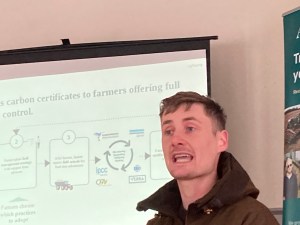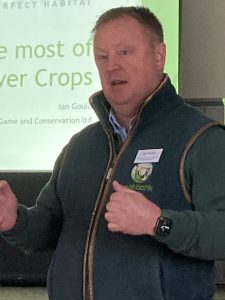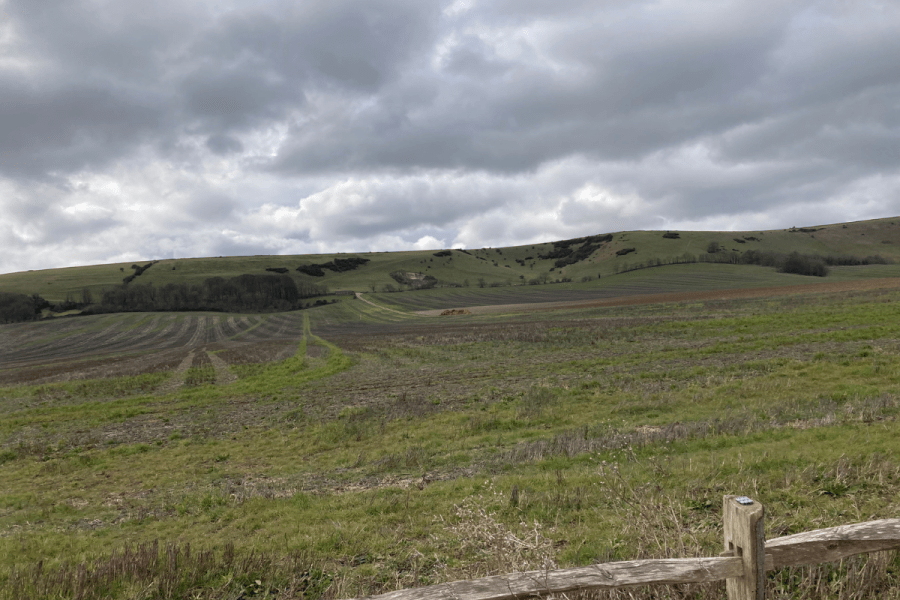Sequestering carbon and reduced CO2 emissions are broader societal benefits of min- and no-till practices already adopted by many arable farms for cost and soil structure reasons. CPM attends a ‘regenerative agriculture day’ in Sussex to learn how to turn these benefits into income.
“Most farms average one to two certificates per hectare, each an annually produced, tradeable asset with a £25 to £50 market value.”
By Lucy de la Pasture
The value of farm carbon credits, both to crop processors and external companies looking to offset their more difficult-to-reduce carbon emissions, means they could provide those subscribing to carbon schemes with significant additional income, aiding the sustainability of farm businesses and their soils.
Committing to such a scheme, though, requires more than simply reducing or eliminating tillage to cut soil disturbance emissions, emphasised speakers at a Sussex on-farm day, co-organised by co-operative Fram Farmers and Danish-based global carbon certification company Agreena.
The latter firm’s UK market lead, Thomas Gent, outlined how the whole process works should a farmer choose to commit to carbon measurement with Agreena, culminating in the certificates that prove a business’s carbon sequestration credentials.

Agreena’s Thomas Gent explained most farms average one to two carbon certificates/ha, each an annually-produced tradeable asset with a £20 to £40 market value.
“Agreena’s carbon certificates are currently available under the ISO 14064-2 standard, with a methodology that is fully aligned to the IPCC guidelines. The company is undergoing accreditation with Verra, completion of the process is expected later this year,” he explained.
“Using our measurement and modelling techniques, plus data recorded by the farmer, we’re able to accurately calculate carbon emissions per hectare for each field a farmer chooses to enter into the programme. There’s no obligation to enter all of a farm’s acreage, and fields can be withdrawn if, for example, ploughing is necessary for a weed control reset or a root crop.”
“Issued certificates can be sold by the farmer owner, or we can handle the trading process. Alternatively, they can be offset against a farm’s other business activities should there be any that have a significant CO2 output, or they can be used to earn a premium from a carbon reduction-committed buyer for crops sold to them.”
Marketed carbon credit certificates tend to be bought as carbon offsets by businesses, such as large manufacturers and consumer product companies, that currently face difficulties in significantly cutting their emissions in the short-term as they transition to lower-emissions technologies. They also have a role to cover residuals where emissions have been reduced as far as they can be but cannot fully be eliminated, he explained.
Thomas also told delegates that buying credits and incentivising farmers’ transition to regenerative farming techniques supports the sector in its move towards net zero.
The certification process essentially comprises a two-way combination of farmer provision of required data to Agreena, and the company’s own verification and additional capture of further information. The former includes details of how fields have been and will be managed, including soil types, cropping, fertiliser applications and work operations, while the latter consists of processes including soil sampling to assess carbon content.
“Data is entered into a scenario planning tool that calculates each field’s carbon emissions and the number of carbon certificates it should yield. After harvest, calculations are revised with the incorporation of actual activities versus those that were planned – crop type, operations, and yields may have differed from those planned or budgeted.
“These are supported by the tools we use, including satellite imagery, data analysis, soil sampling, and random field inspection, to achieve as accurate a measurement as possible of carbon sequestration,” he explained.
“Our computer modelling measures carbon production activities, such as emissions from diesel and fertiliser against carbon sequestration activities – for example, cover cropping, no-till and residue management – to calculate the resulting number of certificates, each representing the equivalent of one tonne of CO2.
“It’s technically possible to obtain up to three certificates per hectare, but most farms average one to two, each an annually produced, tradeable asset with a £25 to £50 market value.”
Thomas went on to explain that 10% of issued certificates are retained to incentivise farmers to commit long-term to good carbon sequestration practice, and these are forfeited should the farmer choose to leave the programme. However, there are no other penalties for doing so, and users can withdraw and re-enter fields, as necessary, an example being for a root crop or if ploughing is necessary for weed control.
Agreena recently opened its 2023 carbon programme for new and existing participants, with interested parties advised to apply well before the June 30 closing date.
Cover crops
Having become popular for over-winter soil and nutrient preservation properties, cover crops also act as an efficient method of sequestering significant carbon, suggested Ian Gould, of seed mix specialists Oakbank Game, who spoke at the event.

Creation of humus built up by cover crops makes it possible to enlarge a farm vertically through increased soil depth, suggested Oakbank’s Ian Gould.
“The effects of rooting properties on soil structure mean well-chosen mixes can help reduce cultivation requirements and consequent soil and tractor carbon output. Some species are particularly good at cycling carbon via glomalin, a sugary carbon exudate from root hairs. This binds silt, sand and clay particles, helping open pores for water, air, nutrients and the decaying biological matter that holds carbon.
“Strong growth of good cover should help minimise slow rainfall impact, aiding infiltration. At the other end of its season, ahead of cash crop planting, cover crop breakdown can boost soil depth through humus creation, helping nutrient, water and carbon retention.”
Ian suggested that those considering the introduction of cover crops to their systems should first set their goals, which could include moisture retention on light land or drawing moisture from wetter, heavier ground – although he urged adopters to first address any drainage problems causing the latter issue.
“Then select your species and mix. Multiple species blends – including vetches, phacelia, linseed, cereals and buckwheat – will feed a spread of soil biology, particularly if also combining different varieties, broadening activity and further aiding carbon capture.
“And the bigger the biomass, the greater its rooting and nutrient retention capabilities. This can benefit drought resilience and minimise plant stress over the long term, particularly at tillering and grain fill, where better rooting because of the enhanced soil profile can delay the effects of drought by 7-10 days.
“Establishment as soon as possible post-harvest will help preserve maximum moisture, with drilling rather than broadcasting best to ensure maximum seed to soil contact.”
Agronomy decisions

Cover crops bring benefits to soil structure and carbon sequestration, but can pose issues with harbouring insect pests, noted agronomist Richard Cartwright.
Agronomist for the 1200ha host for the day, Iford Estate, is Richard Cartwright of CCC Agronomy. He explained that beyond the minimal soil movement strategy adopted by estate managing director Ben Taylor, a number of other strategies had been adopted to minimise carbon release during the cropping year.
“Ben is very much focused on managing the estate in an integrated fashion, and this includes accounting for the range of variability across the land. This has been a factor in the recent creation of significant plans to consider the best future use for poorer areas, which may be better reverted to downland or planted to trees. The cost of targeting high yields and margins on these areas is considerable, and there are environmental drawbacks.
“Much of the soil here is thin, flinty chalk, but it’s capable of decent yields – the estate achieved a very respectable milling wheat average of 12t/ha during harvest 2022, despite the lack of rainfall and the harvest heat. I’d put some of that down to the regenerative, carbon-capturing practices Ben has adopted, from minimal soil disturbance to extensive use of variety blends.”
Wide use is currently made of Crusoe, RGT Illustrious and KWS Zyatt in a three-way Group 1 winter wheat blend, with the aim of providing a mix of disease resistance qualities and protein performance. The approach has been a significant factor in achieving consistently good milling wheat yields at target protein levels, said Richard.
Meanwhile, one of the estate’s key spring crops, barley, is already bringing more to the bottom line through the business’s carbon accreditation efforts.
“Barley is one of the key spring crops in the rotation, and this year much is down to Null-Lox variety CB Score. This is providing a direct example of reward for meeting a buyer’s environmental requirements.
“The crop is earning a significant premium for the carbon-efficient way it’s being produced, based on assessments including deep nitrogen testing, use of a cover crop beforehand, and a commitment to three different crops in five years. This is the first time the estate has been rewarded directly for changing its farming practices.”
Iford is performing regular assessments and taking deep nitrogen samples to better assess the effect of reduced ground movement, the use of cover crops and a wider cropping mix on residual soil N. Cover crop seed, including linseed, phacelia and buckwheat, is being home-grown.
But there have been some cover crop challenges, added Richard. “Increased slug activity is the primary one, especially on heavier ground in wet autumns. Harbouring others pests such as leatherjackets and wireworm and the BYDV risk is also a concern. But I think overall they have significant value.”
This article was taken from the latest issue of CPM. For more articles like this, subscribe here.
Sign up for Crop Production Magazine’s FREE e-newsletter here.




